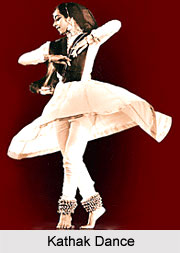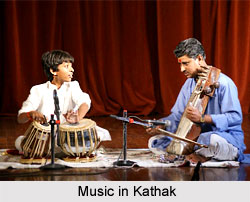 Kathak is regarded as the most prominent dynamic theatre art. The word Kathak has been derived from the word 'katha', which means 'the storytelling art'. It has theatrical representation of themes from Urdu and Persian poetry along with some taken from the Hindu mythology. With dance, music and mime these storytellers of ancient India would bring to life the great scriptures and epic of ancient times, especially the great Indian epics, like, the Mahabharata, Ramayanaand the Indian Puranas.
Kathak is regarded as the most prominent dynamic theatre art. The word Kathak has been derived from the word 'katha', which means 'the storytelling art'. It has theatrical representation of themes from Urdu and Persian poetry along with some taken from the Hindu mythology. With dance, music and mime these storytellers of ancient India would bring to life the great scriptures and epic of ancient times, especially the great Indian epics, like, the Mahabharata, Ramayanaand the Indian Puranas.History of Kathak
The earliest reference to the art of Kathak is found in Mahabharata, the great epic poem written about five centuries ago. At this early phase the art of Kathak was performed by a group of Brahmins in praise of the lord. Around the 16th century AD, when the royal courts of the Hindu maharajas and the Muslim Nawabs patronized the art, it acquired secular elements and sophistication especially in the pure dance or Nritta aspect. Here Kathak encountered various other dance and music forms, where the dancers were lured from temples in order to perform in courts by presenting those gifts of silver, gold, jewels and other royal favour.
Miniature painting provides revealing evidence of the development of a dance form which resolve itself into the Kathak style ultimately. The beginnings of the style can be traced back to the dance illustrated in Jain paintings and manuscripts specifically the Kalpa Sutra. The dancer is depicted here in the ardhamandali position. In Rajasthani paintings there are illustration of the Dasama skanda of the Bhagvata where Krishna dances with the gopis. There are several other illustrations of Lord Krishna like this. There are thousands of paintings depicting secular dance or the female dancer in either a court or in a garden.
Style and Technique of Kathak
 The technique is characterized by fast rhythmic footsteps, accompanied by music, where the dance movements include numerous pirouettes executed at lightning speed and ending in statuesque poses. Kathak conceives of space only in straight lines. There is only a front-back treatment of space. Pirouettes are executed along a central vertical median from which no shifts take place. The weight of the body initially equally divided and the knees are not flexed. Kathak demands minute foot-work. Kathak dancer places the flat foot forward lightly carrying the body weight along. The alphabet and vocabulary of dance movements are conditioned by the metrical cycles on which rhythmic variations can be implemented.
The technique is characterized by fast rhythmic footsteps, accompanied by music, where the dance movements include numerous pirouettes executed at lightning speed and ending in statuesque poses. Kathak conceives of space only in straight lines. There is only a front-back treatment of space. Pirouettes are executed along a central vertical median from which no shifts take place. The weight of the body initially equally divided and the knees are not flexed. Kathak demands minute foot-work. Kathak dancer places the flat foot forward lightly carrying the body weight along. The alphabet and vocabulary of dance movements are conditioned by the metrical cycles on which rhythmic variations can be implemented.Costumes of Kathak
The Kathak female dancers wear a Ghaghara, a choli and a veil. For the men, the costume includes Dhoti-Kurta or Kameez-Churidar-Vest. Gold and silver ornaments are used for head, neck, arms, hands fingers, waist and feet. Ankle bells are also an essential part of adornment. The tinkling bells not only heighten the movement of the dancing foot and helps in dancing many complex patterns and designs. As per the jewellery, they include: Bangles, Earrings, Hair and Finger ornaments are also used.
In the 16th century tight churidar pyjama appears as a standard dress of Kathak. Even if the dancer wears a full-skirted lehenga, the churidar pyjama below is seen. Prior to the 17th century, the women danced to the beats of the Mridanga and the Manjira. Gradually, there is less inclination to the ardhamandali position and the dancer begins to have a straight and erect posture. The dance could not remain away from the growth and development of north Indian music, specially the khayal. Both the dhrupad and the khayal accompanied the dance. The distinctions between Lasya and Tandava and between Nritta and abhinaya were kept intact in Kathak. This dance-style was given a direction by the Vaishnavite tradition of north India. In the process of making dance an abstract design, the dancer never forgot that it was an invocation to God.
For more, visit the link below: